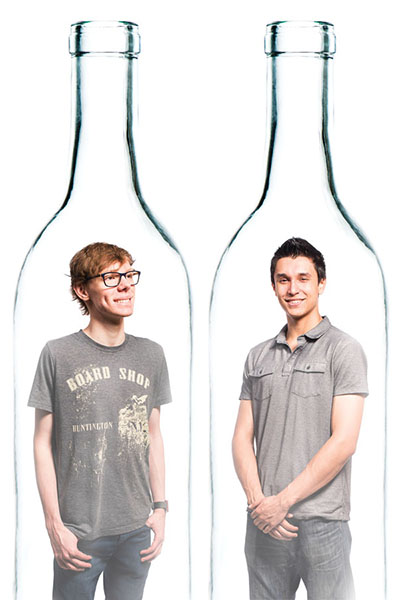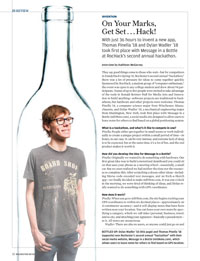In Review
 BOTTLED UP: Dylan Wadler ’18 (left) and Thomas Pinella ’18 won Rochester’s second annual “hackathon” with their social media website, Message in a Bottle (mibNote.com), which allows users to leave notes for others to find based on GPS location. (Photo: Adam Fenster)
BOTTLED UP: Dylan Wadler ’18 (left) and Thomas Pinella ’18 won Rochester’s second annual “hackathon” with their social media website, Message in a Bottle (mibNote.com), which allows users to leave notes for others to find based on GPS location. (Photo: Adam Fenster)They say good things come to those who wait—but for competitors in DandyHack’s Spring ’15, Rochester’s second annual “hackathon,” there was a lot of pressure for ideas to come together quickly. Sponsored by RocHack, a student group of “computer enthusiasts,” the event was open to any college student and drew about 94 participants. Teams of up to five people were invited to take advantage of the tools in Ronald Rettner Hall for Media Arts and Innovation to build anything—software projects are traditional in hackathons, but hardware and other projects were welcome. Thomas Pinella ’18, a computer science major from Winchester, Massachusetts, and Dylan Wadler ’18, a mechanical engineering major from Huntington, New York, took first place with Message in a Bottle (mibNote.com), a social media site designed to allow users to leave notes for others to find based on a global positioning system.
What is a hackathon, and what’s it like to compete in one?
Pinella: People either get together in small teams or work individually to create a unique project within a small period of time—36 hours, in our case. It can be very intense, and extreme lack of sleep is to be expected, but at the same time, it’s a lot of fun, and the end product makes it worth it.
How did you develop the idea for Message in a Bottle?
Pinella: Originally we wanted to do something with hardware. Our first great idea was to build a motorized skateboard you could sit on that uses your phone as a steering wheel—essentially, a small car. But we soon realized we had neither the time nor the resources to complete this. After scratching a dozen other ideas—including Morse code encoded text messages, and an Etch-a-Sketch app—we finally decided to make mibNote.com. It was one o’clock in the morning, we were tired of thinking of ideas, and Dylan really wanted to do something with GPS coordinates.
How does it work?
Pinella: When you go to mibNote.com, the site begins tracking your GPS coordinates to within six decimal places—approximately an 11-centimeter accuracy—and it will display notes that have been written near your location. You can leave your own notes by specifying a category, which we call tides (personal, business, travel, and so on), and attaching your signature—basically a pseudonym—to it. All notes are anonymous.
Wadler: There are also no users, so anyone could just go on and post a note. It encapsulates the idea of not really knowing who the sender is and just receiving a note in a bottle. That’s where the name comes from.
How would you like to develop it further?
Pinella: First, we want the site to look prettier. Eventually, we also want to add a revenue-making part so that we can pay for more hosting and make some profit. We were thinking that businesses could pay a monthly subscription that would allow them to leave notes advertising their businesses, and it would give them added features, such as being able to add images to their notes.
Wadler: I am going to work on an app for the Pebble smartwatch, possibly alongside an app for Android phones. That way more people could use mibNote without having to access a web browser.
How did being in the hackathon influence the app you developed?
Wadler: Coming up with ideas is always difficult, but with constraints I find that something awesome can come out of it. Having almost no time to complete our project, let alone think of an idea, couldn’t have been replicated outside the hackathon.
Pinella: Without the hackathon, there’s no way I would have spent close to eight hours trying to think of a cool idea to pursue. It acted as a catalyst and helped keep us focused. How can you procrastinate when you know that you have less than 36 hours total to create something from scratch?
What advice do you have for people interested in competing?
Wadler: You don’t have to reinvent the wheel. I know it’s by far the most interesting to do, and probably rewarding, to go and write all your code from scratch, or build something out of raw materials—but you just can’t in such a narrow time frame. Hacking is the idea of taking things around you and making something new out of them, so don’t be afraid to break things. Take baby steps. You’ll get to your end-goal if you get there in increments.
Pinella: I can now see the advantage of having an idea of what you want to do before the hackathon begins. That way, you can get started immediately. But don’t let not having an idea stop you from competing in a hackathon. It’s still a lot of fun, and you will probably think of something that you otherwise never would have thought of doing. But whatever your idea is, pursue it and finish it. The last 10 percent of a project can be the most difficult to complete, but also the most rewarding and the most important. A finished project is almost always more impressive than a half-finished project, even if it was a great idea. And get at least a few hours of sleep—it helps.

